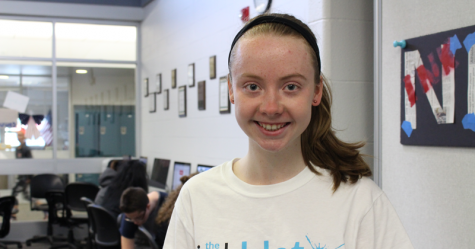The Inkblot celebrates fifteen years of journalism
April 20, 2017
“The News of Communications High School” has not taken a break since 2002.
With 87 issues, The Inkblot has reached thousands of readers, triumphed in state and national competitions and enabled CHS students to put their journalistic theories to practice. The student-produced publication has existed almost as long as CHS itself. And though it has evolved and expanded throughout its history, The Inkblot had humble beginnings.
The Birth of the ‘Blot
Journalism teacher and Inkblot adviser Andi Mulshine has been the club’s adviser since its advent. Mulshine said she joined the staff of CHS when the school’s first class were juniors. She inherited the school’s fledgling newsletter called “The Communicator,” which was started by then-English teacher Jim Fiasconaro and the first class. Fiascanaro said the newspaper comprised of mainly contributions from students about school events.
“The staff of the newspaper consisted of a few highly motivated girls who worked diligently after school,” Fiascanaro said. “The students who worked on ‘The Communicator’ were among the best students I ever met in my school career, including my present college and graduate students [at Kean University].”
Lara Oakes, now Lara Lyberg, was the Editor-in-Chief of “The Communicator” and later served as the face of The Inkblot for both her junior and senior years.
“My hope was to create a successful, lasting club that my peers and students afterward would benefit from being part of. The most enjoyable part for me was seeing club members share their writing and artistic talents,” Lyberg said.
Under Mulshine’s advisement, the staff moved on from “The Communicator” and made the publication a true newspaper: 11-by-17 inches in size with an editorial board. But the paper needed a new name, Mulshine said.
“We were all in a room, brainstorming what we wanted to call it. We had so many words on the board, but we just didn’t feel right,” Mulshine said. All of the sudden, Mulshine said Bobby Picardo, Class of 2005, said the words: “The Inkblot.”
Picardo said the name evolved from studying the history of journalism and its earliest forms.
“I’m a very big fan of colonial Williamsburg, and my favorite place I saw there was the printing press. I was amazed that just a blot of ink made the newspaper,” Picardo said. He and then Editor-in-Chief, and still dear friend, Anna Sweeney, wanted a name with “a throwback feel.”
“I was adamant it was the best name, and the name stuck immediately.”
Fifteen years later, Picardo said creating the paper’s namesake is his most memorable achievement at CHS.
“It is what I’m most proud of. Even as class president for three years and SGA president for one, I’m most proud of quality of work that continues with The Inkblot.”
After Picardo created the name, classmate Dan Brateris proposed the layout and original logo, Lyberg said. With between 20 and 30 members, The Inkblot’s inaugural staff produced the first editions of the paper. While current Inkblots are usually 12 or 16 pages, Mulshine said the paper averaged eight pages the first few years.
“We had our hands full with eight,” Mulshine said.
Slowly the paper began to attract more participation, and Mulshine said that 2006 was a turning point for the publication.
“They were more serious journalists. It was the second year of kids who had been through sophomore journalism,” Mulshine said. “From ‘07 onward, it was really a big club.”
In Depth Reporting
Each year, Mulshine reviews hundreds of students stories and art for the paper, but a few memorable pieces – from lighthearted features pieces to some heavier, even controversial, stories – have distinguished themselves from the rest.
In 2006, the Danish newspaper Jyllands-Posten printed a cartoon depicting “the Prophet Mohammed as a terrorist with a bomb,” according to the Telegraph. As a result, there were riots in Muslim communities, as any image of Mohammed defies certain principles of the Muslim faith, according to CNN. Protesters appeared outside the offices of publications, including that of Signe Wilkinson, a cartoonist at the Philadelphia Daily News, who drew a similar cartoon in solidarity with the cartoonists in Europe.
“We were really interested because it was a first amendment issue…So we got a hold of her, and we interviewed her. She gave us cartoons to use. I think that was probably the best story in my mind because it was outside, and it was on a national issue, international even,” Mulshine said.
Another piece that impressed Mulshine was a cartoon created by John ____, Class of ____.
“I gave him a challenge. I asked him to draw what the human body will look like in the year 3000. He had USB ports for hands, and a gigantic stomach because all we did was sit. There were arms and legs, but there was nothing to them because they never got exercise. It was beautiful, and he won a national award and his cartoon wound up in a scholastic magazine,” Mulshine said. “Our cartoonists have a long, storied history here.”
The Inkblot & ‘The Man’
Mulshine said a key to the paper’s success has been the cooperation of the administration.
“I can say, without reservation, that we have never been censored. We have never had prior review, and it’s been 15 years,” Mulshine said. She added that with the mental health spread in 20XX and the sex spread in 2017, Principal Gleason wanted to discuss the topic with the relevant editors to share any concerns he or the guidance counselors had with the subjects. But each time, Mulshine said the necessary precautions were taken and the paper was allowed to continue with its stories.
Impact on CHS
Mulshine said another significant factor in the success of The Inkblot is the very nature of the club, in that writers can see the work they’ve put in.
“It’s instant gratification for working hard. It is not an easy club. It’s probably the hardest club that you’ll be a member of but also the most rewarding.”
Principal James Gleason said he believes having an established newspaper like The Inkblot has attracted prospective students to CHS.
“I definitely think that The Inkblot is a draw. It is an outstanding example of student work, with a great adviser, and just a great product.”
Gleason attributed the main factor in The Inkblot’s success to Mulshine’s advisement.
“Her dedication and passion for her craft, and her willingness to spend a tremendous amount of hours with young adults to craft the paper is why it is successful.”
In addition, Gleason feels The Inkblot is an integral part of journalism at CHS.
“Even more so today, journalism is a vital track for student expression. That doesn’t mean that students need to learn everything about being a journalist, but they learn how to go after a story, interview and write a balanced story, seeing all sides,” Gleason said. “That is a vital part of society and being an American.”
Memorable Stories for Faculty
For teachers who’ve read the paper since they started at CHS, certain stories have stood out as particularly memorable. Math teacher Scott Stengele remembered a story with a special place in his heart that was published in 2014 about his daughter, Hannah.
“They did a story on Hannah when she was in the Special Olympics National games. She came here and they interviewed her and everything. And they kind of included me, as someone who has taken a couple days off from school to go watch the event and cheer her on,” Stengele said. “She got a kick out of being interviewed for the paper.”
Fitness teacher Ginny Clevenger has a tradition in The Inkblot: writing an annual poem about the graduating senior class.
“As the Poet Laureate of the Inkblot I must give a shout out to my silly poems. I wrote the first one for the Class of 2007,” Clevenger said. “Another favorite was 12/03 when a picture of me at age 5 visiting Santa made the cover.”
Saying Goodbye
This year, as same as every year, Mulshine will bid adieu to senior staff members. As these students move on from The Inkblot, Mulshine hopes they will take some key lessons away from their experience on the paper.
“I hope they became better writers. I hope they are more inquisitive about the world around them. But more of all, I hope they have the courage to express themselves when they want to and when they need to,” Mulshine said. “What’s the saying… ‘Speak truth to power.’ I hope they will always know that they can.”





